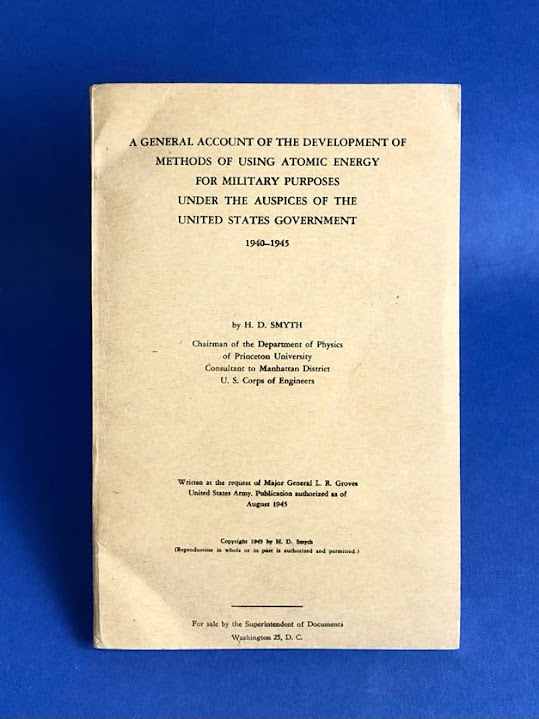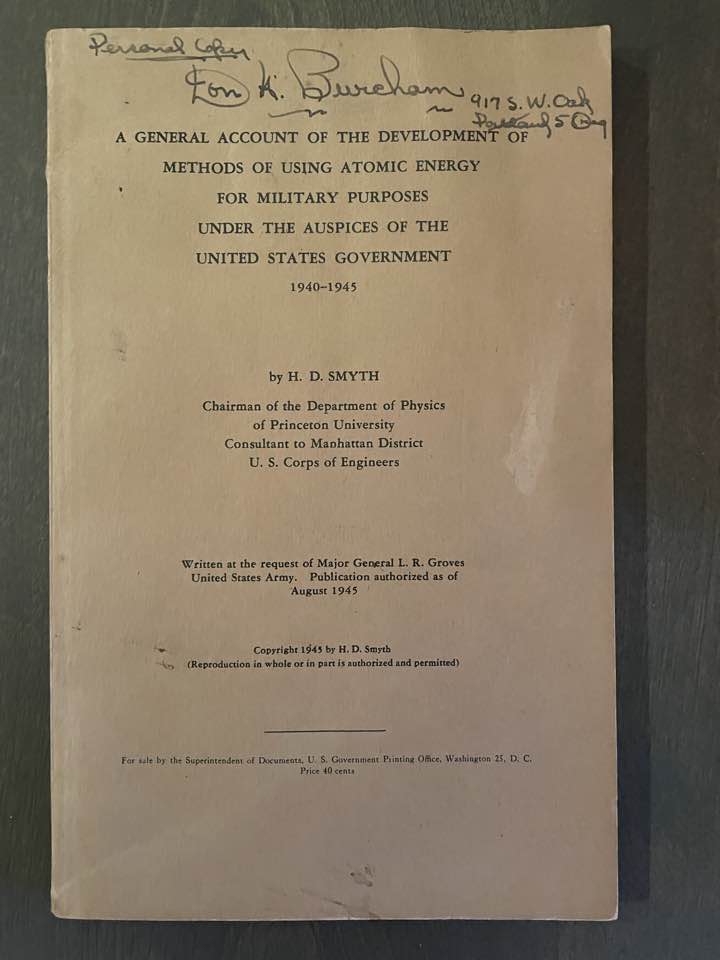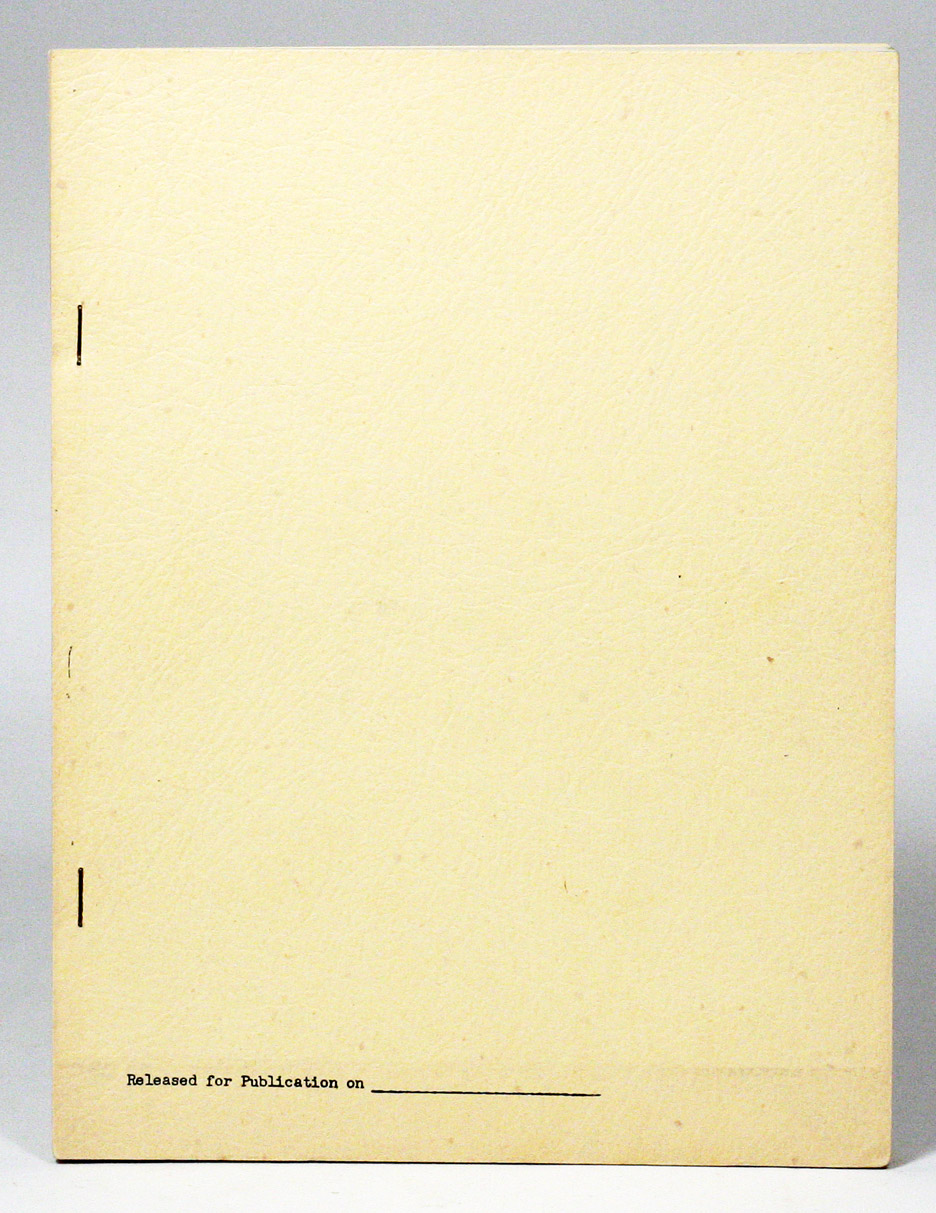Available Copies from Independent Booksellers

Price: US$100.00 + shipping
Condition: Near Fine
Description: 8vo. 182 pp. Beige wraps w/ black titling. Slight wrinkling to wrappers. Interior clean, binding sound. Laid in bundle of ephemera containing a Government Printing office order form, newspaper clipping calling Smyth "Mr. Atom", and receipt of payment addressed to Clara C. Haas, M.D. Haas was formerly the head of the Department of Social Welfare at the State Hospital for Mental Diseases in Howard, Rhode Island.
Seller: Small Volume Books, Providence, RI, U.S.A.

Price: US$297.00 + shipping
Description: First English edition, reprinted from very scarce U.S. Government Printing Office edition. With a number of formula and some diagrams. Small 4to, 245 x 153 mm., in the publisher's original buff paper wrappers printed in black, now housed in an attractive fold-over case of tan buckram with a black morocco label gilt ruled and lettered. iv, 144 pp. A fine and surprisingly fresh copy of this very scarce printing, the wrappers with only some minor spotting, the text near as pristine. VERY SCARCE FIRST BRITISH ISSUE OF "THE SMYTH REPORT", ANNOUNCING THE BIRTH OF A NEW WORLD ORDER AND A NEW "AGE" IN HUMAN HISTORY. "A remarkably full and candid account of the development work carried out between 1940 and 1945 by the American directed but internationally recruited team of physicists,under the code name of Manhattan District, which culminated in the production of the first Atomic Bomb." - PMM. Commonly called "The Smyth Report" due to its somewhat unwieldy name, this was reprinted from the issue released by the United States Government Printing Office and precedes the first trade edition published by Princeton University Press. The text is an administrative history written by physicist Henry DeWolf Smyth about the Allied World War II effort to develop the atomic bomb. The mimeographed prepublication issue was released to the press on August 12, 1945, after the atomic bombings of Hiroshima and Nagasaki on August 6 and 9. It was set by typewriter and printed on mimeograph machines in offices at the War Department. That issue is extremely scarce and usually found badly worn or damaged. General Leslie Groves ordered Smyth to write the Report at Los Alamos during the later days of the Manhattan Project. He gave two reasons for its production. The first was for there to be an official U.S. government history and statement about the development of the atomic bombs. Thus it outlines the development of the then secret laboratories and production sites at Los Alamos, New Mexico, Oak Ridge, Tennessee and Hanford, Washington. The report also was to give some background to the basic physical processes necessary for the viability of nuclear weaponry, in particular, nuclear fission and the nuclear chain reaction. Second, it served as a indicator for the relevant scientists as to what information was declassified and what information was still "top secret". Anything discussed in the Smyth Report could be used freely in the literature available for public consumption. The stated purpose of the Smyth Report was to give enough information to the American citizenry that it could understand enough about the new atomic weaponry to make sense of policy decisions regarding them. Smyth, in his preface states, "The ultimate responsibility for our nation's policy rests on its citizens and they can discharge such responsibilities wisely only if they are informed." In spite of extensive security review before it was released, the Smyth Report was criticized by many as having "given away the secret of the A-bomb." And It was in fact used extensively in the Soviet Union in formulating that countrys A-bomb project. The value to the Soviets by-in-large however, was relevant in terms of what sort of factories to build and in order to compare Soviet progress with the scale of the American project. This original pre-publication issue does differ slightly from the published account issued by Princeton University. Groves decided a one sentence allusion to a "poisoning" effect in the production reactors, which stopped the reaction, was sensitive and he had it removed. This deletion was soon noticed in Russia, and many believe served only to highlight its importance. Also, in the Princeton publication, Smyth's first and middle names were added instead of the previous use of abbreviations. Despite the technical nature of the work, the published edition sold almost 127,000 copies in its first eight printings and was on the New York Times best-seller list from mid-October 1945 until late-January 1946. The Soviet Union did play some role in this commercial success as it is believed they may have purchased well over 1000 copies of the U.S.G.P.O. printing.
Seller: Buddenbrooks, Inc., Newburyport, MA, U.S.A.

Price: US$375.00 + shipping
Condition: Very Good
Description: First printed edition Preceded by the very rare lithoprint edition. Octavo. 182 pp. Publisher's printed beige cardboard wrappers. Previous owner's name and address at top margin of front wrapper (neat and legible). A very good copy. Published on August 12, 1945, only six days after Hiroshima, the remarkably full and candid account of the development work carried out between 1940 and 1945 by the American-directed but internationally recruited team of physicists, under the code name of 'Manhattan District,' which culminated in the production of the first atomic bomb. Professor Henry DeWolf Smyth of Princeton, a consultant to the 'Manhattan District' project at Los Alamos, whose commandant General L.R. Groves provided the foreword, 'The Smyth Report,' as it is familiarly known, was published at one dollar by the U.S. Superintendent of Documents. [It was preceded by a preliminary mimeographed version prepared for press use.] Earle E. Coleman, "The Smyth Report: A Descriptive Check List," Princeton University Library Chronicle 37/3 (Spring 1976); 204-218, nos. 5, 4. Printing and the Mind of Man 422e.
Seller: Reginald C. Williams Rare Books, Glendale, CA, U.S.A.

Price: US$497.20 + shipping
Condition: Fine
Description: ---- 1. A GENERAL ACCOUNT OF THE DEVELOPMENT OF METHODS OF USING ATOMIC ENERGY FOR MILITARY PURPOSES under the auspices of the United States Government,1940/1945, written at the request of Major General L.R. GROVES, United States army. Publication authorized as of August 1945. Washington, For sale by the Superintendent of Documents, 1945, 7pp., 182pp., couvertures imprimées conservées --- 2. The United States and the United Nations report series. THE INTERNATIONAL CONTROL OF ATOMIC ENERGY. Scientific information transmitted to the United Nations Atomic Energy Commission. June 14, 1946-October 14, 1946. Prepared in the Office of Mr. Bernard M. Baruch, United States Représentative. 6 volumes. Washington, United States Government Printing Office, (2), 195pp., couvertures imprimées conversées --- 3. GRIMALDI (F.S.) - MAY (I.) - FLETCHER (M.H.) - TITCOMB (J.). COLLECTED PAPERS ON METHODS OF ANALYSIS FOR URANIUM AND THORIUM. Geological survey bulletin 1006. Washington, United States Government Printing Office, 1954, 7pp., 184pp., 6 planches dont 5 dépliantes sous étui contrecollé au veso du deuxième plat de couverture, couvertures imprimées conservées --- 4. PIGOTT (E.C.). ATOMIC ENERGY in Review volume 1, N° 14, 1954, pp. 354/387 ---- FIRST EDITION of the first published account of the development of the atomic bomb issued after the first atomic bomb was exploded over Hiroshima. This report, familiarly known and referred to as the "SMYTH REPORT" is also the first officially published description of the immediate history following Hahn's and Strassmann's discovery of nuclear fission in 1939" ---- Statement of the problem - Administrative history up to December 1941 - Progress up to December 1941 - Administrative history (1942-1945) - Metallurgical project at Chicago in 1942 - Plutonium production problem (February 1943) - Plutonium problem (January 1943-June 1945) - General discussion of the separation of Isotopes - Diffusion separation - Electromagnetic separation - The work on the atomic bomb - Production and utilization of uranium-235 and plutonium 239 - The military effectiveness of the atomic bomb - etc**4796/M1
Seller: LIBRAIRIE Bernard MAILLE, PARIS, France

Price: US$500.00 + shipping
Description: Smyth, Henry DeWolf (b. 1898). A general account of the development of methods of using atomic energy for military purposes under the auspices of the United States government 1940-1945. Washington, D.C.: Superintendent of Documents, 1945. iii-vii, [1], 182pp. 230 x 150 mm. Original tan wrappers, slight wear. Fine. Bookplate. First Published Edition, First Printing, with the date "1945" in the colophon on the last printed page. Printing and the Mind of Man 422e. The Smyth report contained a full account of the development work carried out between 1940 and 1945 by the Manhattan Project, which culminated in the production of the first atomic bomb. The printed version of the "Smyth Report" was preceded by an advance lithoprint issue, of which 1000 copies were printed, and a secret mimeographed issue of which no copies except for Smyth's master copy remain extant. Coleman, "The 'Smyth Report': A descriptive checklist," Princeton University Library Chronicle 37 (1976), pp. 204-218. Smyth, "The 'Smyth Report,'" Princeton University Library Chronicle 37 (1976), pp. 173-189. .
Seller: Jeremy Norman's historyofscience, Novato, CA, U.S.A.

Price: US$1000.00 + shipping
Condition: Good
Description: Fold-outs of Hiroshima and Nagasaki. Unpaginated. 101 numbered and captioned figures. Stamp inside front cover. Cover has some wear, soiling and discoloration. Pencil notation on Figure 1 Probable Position of Rising Cloud at Intervals after Explosion. Scale is distance on the horizontal and time on the right vertical and height in the Atmosphere on the left vertical. Physical phenomena comments are made: Violent Winds, Extremely Dangerous Radioactivity, Extreme Turbulence, and Stratosphere Inversion. The Hiroshima fold out map is labeled Restricted and Emergency Provision Edition. The Nagasaki fold out map was for the use of the Army and Navy. Figure 4 is a Pre-strike aerial view of Hiroshima. Image is 3.3 miles by 2.6 miles. Figure 5 is The atomic bomb explosion over Nagasaki, taken from about 8 miles distance. The height of the top of the cloud was about 40,000 feet. Figure 6 is the Atomic Bomb explosion over Hiroshima. Figure 7 is a panoramic view of Hiroshima after the bomb. Figure 8 is an aerial view of Hiroshima after the bomb. Figure 9 is a panoramic view of Nagasaki after the bomb, Figure 10 is an aerial view of Nagasaki after the bomb. Remaining photographs provide more granular images and information. On 11 August, Groves ordered a survey team to report on the damage and radioactivity at Hiroshima and Nagasaki. A party equipped with portable Geiger counters arrived in Hiroshima on 8 September. They remained in Hiroshima until 14 September and then surveyed Nagasaki from 19 September to 8 October. The Manhattan Project was a research and development undertaking during World War II that produced the first nuclear weapons. It was led by the United States with the support of the United Kingdom (which initiated the original Tube Alloys project) and Canada. From 1942 to 1946, the project was under the direction of Major General Leslie Groves of the U. S. Army Corps of Engineers. Nuclear physicist Robert Oppenheimer was the director of the Los Alamos Laboratory that designed the actual bombs. As engineer districts by convention carried the name of the city where they were located, the Army component of the project was designated the Manhattan District, Army leadership decided to call the project "Development of Substitute Materials", but Groves felt that this would draw attention. Since engineer districts normally carried the name of the city where they were located, it was agreed to name the Army's component of the project the Manhattan District. This became official on 13 August 1942, when an order was issued creating the new district. Informally, it was known as the Manhattan Engineer District, or MED. Unlike other districts, it had no geographic boundaries. Development of Substitute Materials remained as the official codename of the project as a whole, but was supplanted over time by "Manhattan". Groves established his headquarters in Washington, D.C., on the fifth floor of the New War Department Building, where Colonel Marshall had his liaison office. He assumed command of the Manhattan Project on 23 September 1942. In anticipation of the bombings, Groves had Henry DeWolf Smyth prepare a history for public consumption. Atomic Energy for Military Purposes, better known as the "Smyth Report", was released to the public on 12 August 1945. The political and cultural impacts of the development of nuclear weapons were profound and far-reaching. William Laurence of The New York Times, the first to use the phrase "Atomic Age", became the official correspondent for the Manhattan Project in spring 1945. In 1943 and 1944 he unsuccessfully attempted to persuade the Office of Censorship to permit writing about the explosive potential of uranium, and government officials felt that he had earned the right to report on the biggest secret of the war. Laurence witnessed both the Trinity test and the bombing of Nagasaki and wrote the official press releases prepared for them. He went on to write a series of articles extolling the virtues of the new weapon.
Seller: Ground Zero Books, Ltd., Silver Spring, MD, U.S.A.

Price: US$5000.00 + shipping
Description: for Military Purposes Under the Auspices of the United States Government 1940 -1945 . Written at the request of Major General L.R. Groves United States Army. [Washington D.C.: printed at the Pentagon, 1945]. First edition, advance publication copy for press use. One of 1,000 copies. Cyclostyled pages, stapled (10 3/8 x 7 7/8 inches; 264 x 200 mm.). [8], 19, [1, blank], 10, 7, [1, blank], 15, [1, blank], 9, [1, blank], 14, 15, [1, blank],17, [1, blank], 13, [1, blank], 10, 13, [1, blank], 12, 3, [1, blank], 6, 2, 3, [1, blank], 5, [1, blank], 1, [1, blank] pp. With intertextual diagrams and "Released for Publication on ____" lithographed on lower inner corner of front wrapper. With duplicate extra leaf "x-5." Complete. Original textured cream wrappers stapled in three places along inner edge. Wrappers slightly soiled. Spine with a small dampstain. Internally very clean. About fine. This is the first edition of the first description of the technical development of the atomic bomb, published on 12 August 1945, just six days after Hiroshima. Until the publication of A General Account research and development had been undertaken in conditions of the utmost secrecy and the report was also prepared in secret. However, the British and American governments decided that the widest dissemination of this "remarkably full and candid account" (PMM) was in the public interest, and this first edition was distributed to journalists for radio use on 11 August and for press use the next day. This first edition with a Foreword by L.R. Groves is described as a "lithoprint" and was printed in the Adjutant General's office in the Pentagon from a typescript. "All pertinent scientific information which can be released to the public at this time without violating the needs of national security is contained in this volume. No requests for additional information should be made to private persons or organizations associated directly or indirectly with the project. Persons disclosing or securing additional information by any means whatsoever without authorization are subject to severe penalties under the Espionage Act" (Groves, from the Foreword). Although it does not state anywhere, this copy belonged to American physicist and director of the Los Alamos National Laboratory, Norris Bradbury. In July 1944, Bradbury a naval commander, transferred to Los Alamos to work on the Manhattan Project. In 1945, Oppenheimer resigned as director of Los Alamos and recommended Bradbury for his replacement. Norman Library 1962. Printing and the Mind of Man, 422e. HBS 67805. $5,000.
Seller: Heritage Book Shop, ABAA, Beverly Hills, CA, U.S.A.

Price: US$7500.00 + shipping
Description: RARE LITHOPRINT ISSUE -THE FIRST OBTAINABLE PRINTING - OF THE FIRST ACCOUNT OF THE MANHATTAN PROJECT AND THE DEVELOPMENT OF THE ATOMIC BOMB. ONE OF SMYTH'S OWN COPIES, SIGNED BY HIM ON THE TITLE PAGE. PMM 422e. Released to the public on 12 August 1945, just six days after the bombing of Hiroshima, the "Smyth Report" (as it came to be known) contained a full account of the development work carried out between 1940 and 1945 by the Manhattan Project that culminated in the production of the first atomic bomb. The first version of the report was a mimeographed copy (identifiable by the word "secret" stamped on every page), hand-delivered by military messenger, which the recipients were required to read immediately and return to the waiting messenger. These mimeographed copies were apparently destroyed for security reasons, as no copies, either whole or in parts, have been recorded in existence except for Smyth's master copy housed at Princeton. 1,000 copies were then lithoprinted from typescript [the offered version] in the facility for reproducing secret documents in the Adjutant General's Office in the Pentagon. Provenance: Smyth was given a small number of copies for his own personal use. In the late 1970s Smyth was cleaning out his office at Princeton and found a few copies of the original lithoprinted version. At the request of Princeton University, he signed the copies and presented them to the university. This is one of those copies. It is complete, and contains three repeated leaves. Because the leaves were gathered for binding in great haste and under the pressure of tight security precautions, the surviving copies often contain missing and/or repeated leaves. No leaves are missing in this copy. References: PMM 422e; Norman 1962; Coleman, The 'Smyth Report': A Descriptive Checklist, no. 3. See: "The 'Smyth Report'" by H.D. Smyth, The Princeton University Library Chronicle, Vol. 37, No. 3, Spring 1976. [Washington, D.C.: Adjutant General's Office, 1945.] Quarto (8x10.5 in.; 265 x 201 mm), stapled in the original cream textured stiff paper covers. Printed by lithoprint from stencils made by multiple typewriters. A little (very minor) soiling to wrappers, but still fine - one of the nicest copies we've seen. RARE SIGNED. Note: A custom box can be made for this item for an additional $250.
Seller: Manhattan Rare Book Company, ABAA, ILAB, New York, NY, U.S.A.